谨个人学习 Java IO 历程
开篇先放一张图
初步了解 输入流 与 输出流 。
将txt文本文件内容 展示到程序中,这是输入。例如将aaa.txt 内容打印在 看控制台 。
在程序中预先设置一些数据 ,传输到aaa.txt 中,这是输出 ,例如将 “hello world” 保存到aaa.txt中 ,
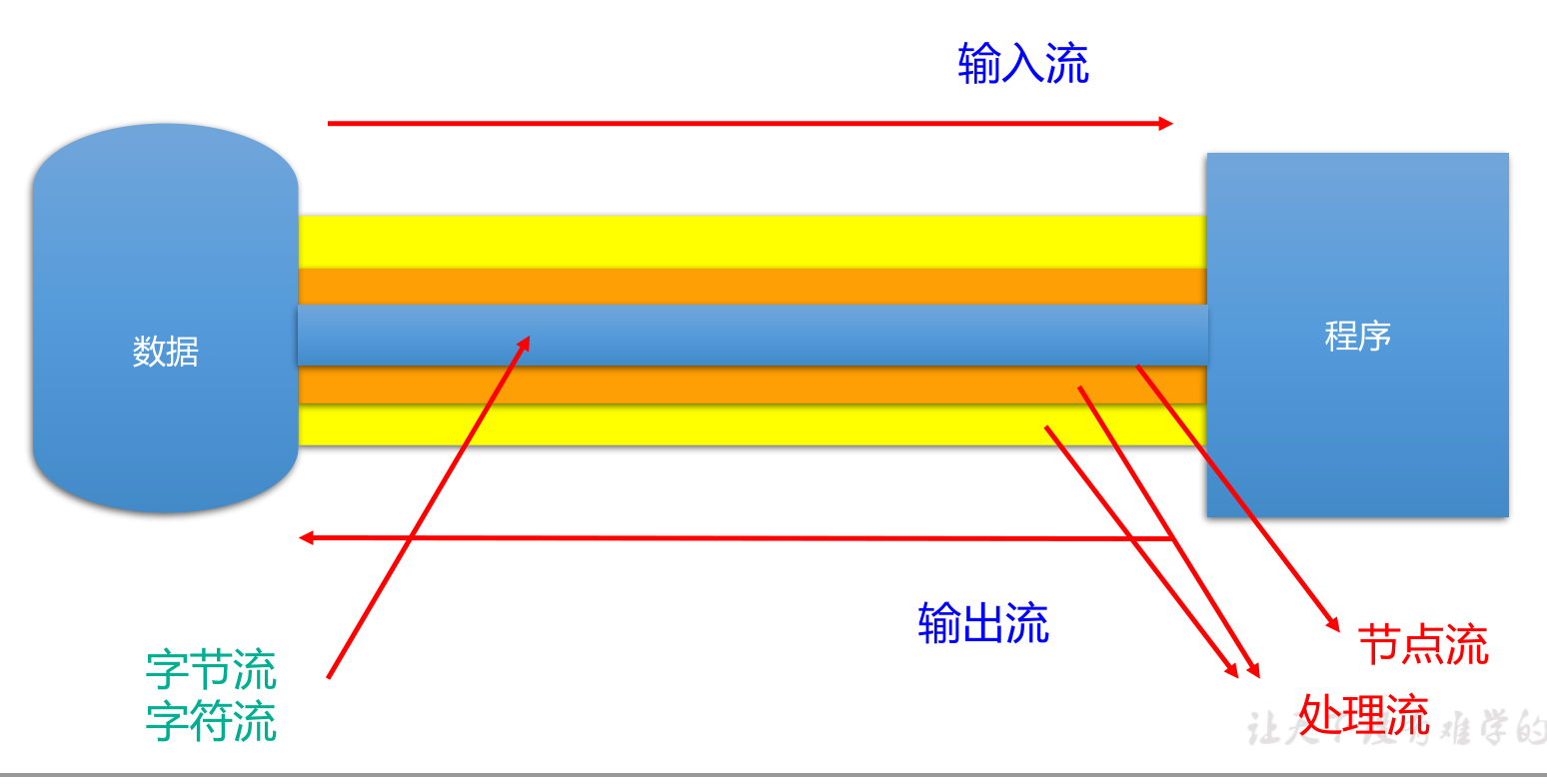
正片即将到来,内容引起不适。🙅
java IO 中常用的类
在 java.io 包中最重要的就是 五个类 和 一个接口 ,五个类 指的是 :
File、OutputStream 、InputStream 、Writer 、Reader ;
一个接口指的是 Serializable 。掌握了 IO 的核心操作 ,那么对应Java IO 体系就有了初步认识 。
- 1、File (文件特征与管理) :用于文件或目录的描述信息 ,例如生成新目录 、修改文件名、删除文件 、判断文件所在路径等 。
- 2、OutputStream (二进制格式操作) :抽象类 ,基于字节的输出操作 ,是所有输出流的父类 。定义了所有输出流都具有的共同特征 。
- 3、InputStream (二进制格式操作) :抽象类 。基于字节的输入操作 ,是所有输入流的父类 。定义了所有输入流都具有的共同特征。
- 4、Reader (文件格式操作) :抽象类 。基于字符的输入操作 。
- 4、Writer (文件格式操作) :抽象类 。基于字符的输出操作 。
IO 体系结构图 :
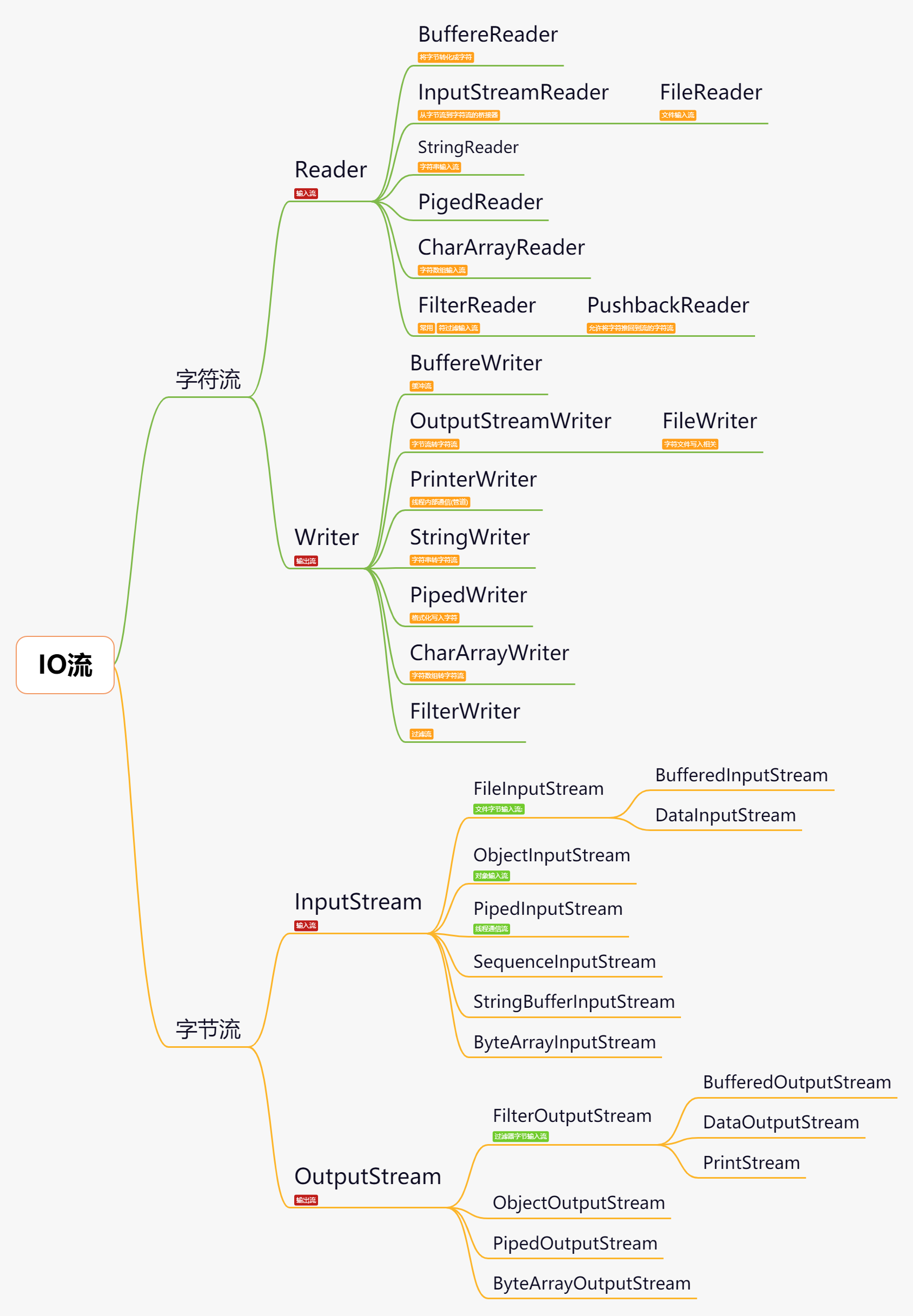
Java的 I/O 操作大概可以分为这几类:
- 磁盘操作:File
- 字节操作:InputStream 和 OutPutStream
- 字符操作:Reader 和 Writer
- 对象操作:Serializable
- 网络操作:Socket
- 新的输入/输出:NIO
File
文件操作步骤流程:
-
1、使用File类打开一个文件
-
2、通过字节流或者字符流的子类,指定输出位置
-
3、进行读写操作
-
4、关闭输入输出流
该类主要用于获取文件和目录的属性,文件和目录的创建、查找、删除、重命名等,但不能对文件进行读写操作。
File对象代表磁盘中实际存在的文件和目录。
File 类的使用:常用构造器
| 构造器 | 作用 |
|---|---|
| public File(String pathname) | 以pathname为路径创建File对象,可以是 绝对路径或者相对路径 绝对路径:是一个固定的路径,从盘符开始 相对路径:是相对于某个位置开始,默认的当前路径在系统属性user.dir中存储 |
| public File(String parent,String child) | 以parent为父路径,child为子路径创建File对象。 |
| public File(File parent,String child) | 根据一个父File对象和子文件路径创建File对象 |
- 1、以pathname为路径创建File对象
File dir1 = new File("D:/IOTest/dir1");
- 2、// 创建以dir1为父目录,名为"dir2"的File对象
File dir2 = new File(dir1, "dir2");
- 3、// 创建以dir2为父目录,名为"test.txt"的File对象
File file = new File(dir2, "test.txt");
File 类的使用:路径分隔符
public static final String separator // 根据操作系统,动态的提供分隔符
// D:\\yuanwu\\info.txt
File file = new File("D:" + File.separator + "yuanwu" + File.separator + "info.txt");
File 类的使用:常用方法
| 方法名称 | 作用 |
|---|---|
| File类的获取功能 | |
| public String getAbsolutePath() | 获取绝对路径 |
| public String getPath() | 获取路径 |
| public String getName() | 获取名称 |
| public String getParent() | 获取上层文件目录路径。若无,返回null |
| public long length() | 获取文件长度(即:字节数)。不能获取目录的长度 |
| public long lastModified() | 获取最后一次的修改时间,毫秒值 |
| public String[] list() | 获取指定目录下的所有文件或者文件目录的名称数组 |
| public File[] listFiles() | 获取指定目录下的所有文件或者文件目录的File数组 |
| File 类的重命名功能 | |
| public boolean renameTo(File dest) | 把文件重命名为指定的文件路径 |
| File类的判断功能 | |
| public boolean isDirectory() | 判断是否时文件目录 |
| public boolean isFile() | 判断是否是文件 |
| public boolean exists() | 判断是否存在 |
| public boolean canRead() | 判断是否可读 |
| public boolean canWrite() | 判断是否可写 |
| public boolean isHidden() | 判断是否隐藏 |
| File类的创建功能 | |
| public boolean createNewFile() | 创建文件。若文件存在,则不创建,返回false 。 |
| public boolean mkdir() | 创建文件目录。 如果此文件目录存在 ,则不创建 如果此文件目录的上层目录不存在 ,也不创建 。 |
| public boolean mkdirs() | 创建文件目录 。如果上传文件目录不存在 ,一并创建 。 |
| File类的删除功能 | |
| public boolean mkdirs() | 删除文件或者文件夹 |
创建注意事项 :如果创建文件或者文件目录没有指定盘符路径 ,默认在项目路径下 。
删除注意事项 :Java 中File类的删除不走回收站 ,要删除一个文件目录 ,请注意该文件目录不能包含文件或者文件目录 。
流的原理及流的分类
| 抽象基类 | 节点流(文件流) | 缓冲流(处理流的一种) |
|---|---|---|
| InputStream (字节输入流,读入数据) | FileInputStream (处理字节) | BufferedInputStream |
| OutputStream (字节输出流,写出数据) | FileOutputStream (处理字节) (byte[] b) | BufferedOutputStream |
| Reader (字符输入流,读入数据) | FileReader (处理字符) | BufferedReader |
| Writer (字符输入流,写出数据) | FileWriter (处理字符) (char[] c) | BufferedWriter |
什么情况下使用哪种流呢?
如果数据所在的文件通过windows自带的记事本打开并能读懂里面的内容,就用字符流,其他用字节流。
如果你什么都不知道,就用字节流。
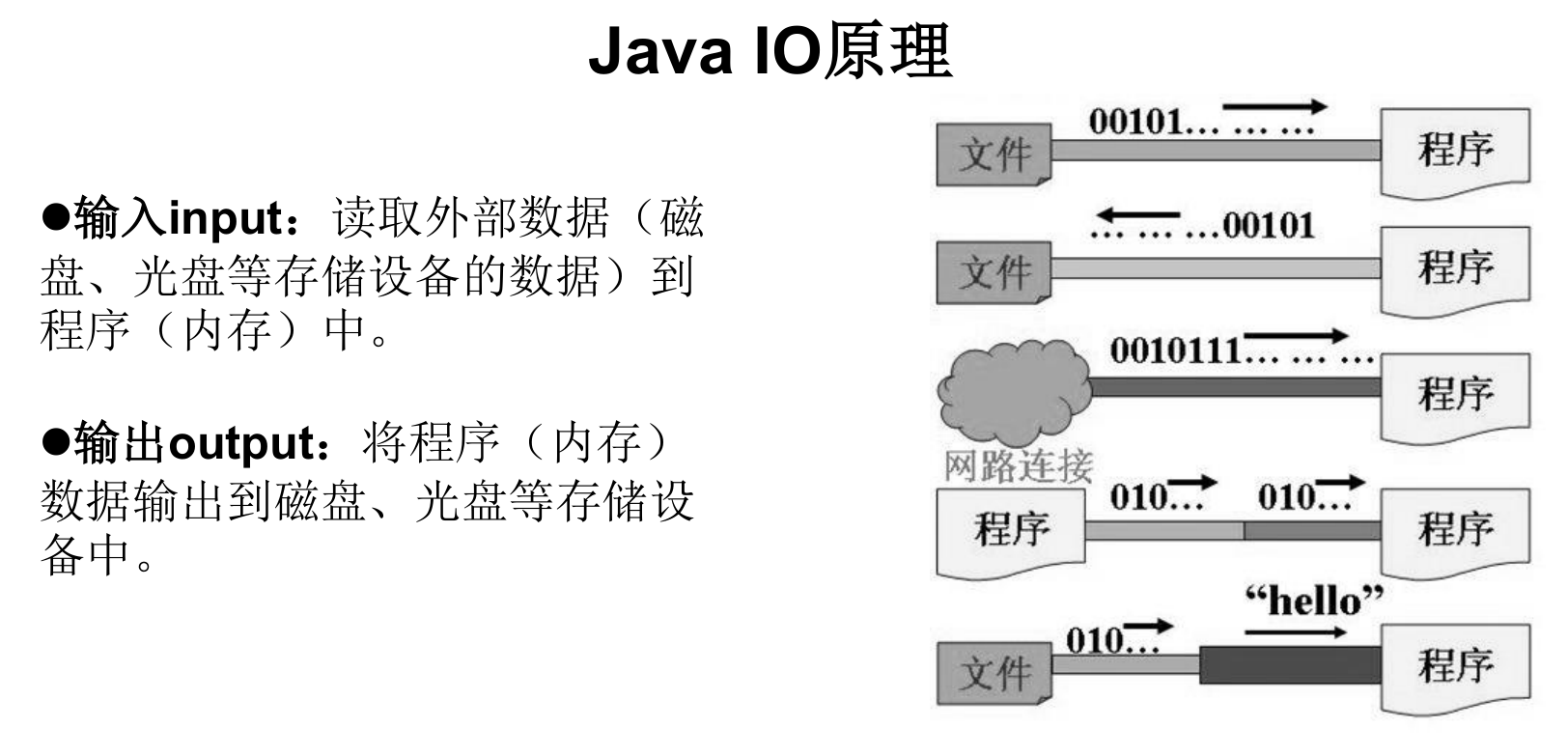
在Java程序中所有的 数据都是以流的方式进行传输或者保存的,程序需要数据的时候使用输入流读取数据,当程序需要将一些数据保存起来则使用输出流。流中保存的实际上是字节文件。
如果数据的流向从程序到设备,成为输出流,反之输入流
- 按操作数据类型分为:字符流(16 bit),字节流(8 bit)
- 按数据流的流向分为:输入流 ,输出流
- 按流的角色可分为 :节点流,处理流
所有的文件在硬盘传输时都是以字节的方式进行的,按字节的方式存储,字符只有在内存中才会形成
字节流
字节流处理数据的基本单元是单个字节(byte),通常用来处理二进制数据
抽象基类:
InputStream,OutputStream,(字节流)
字节流在操作的时候不会用到缓冲区(内存),是直接对文件本身操作的
字符流
Java中字符流处理数据的基本单元是2字节Unicode码元(char),通常用来处理文本数据
抽象基类:
Reader,Writer,(字符流)
字符流在操作的时候会使用到缓冲区
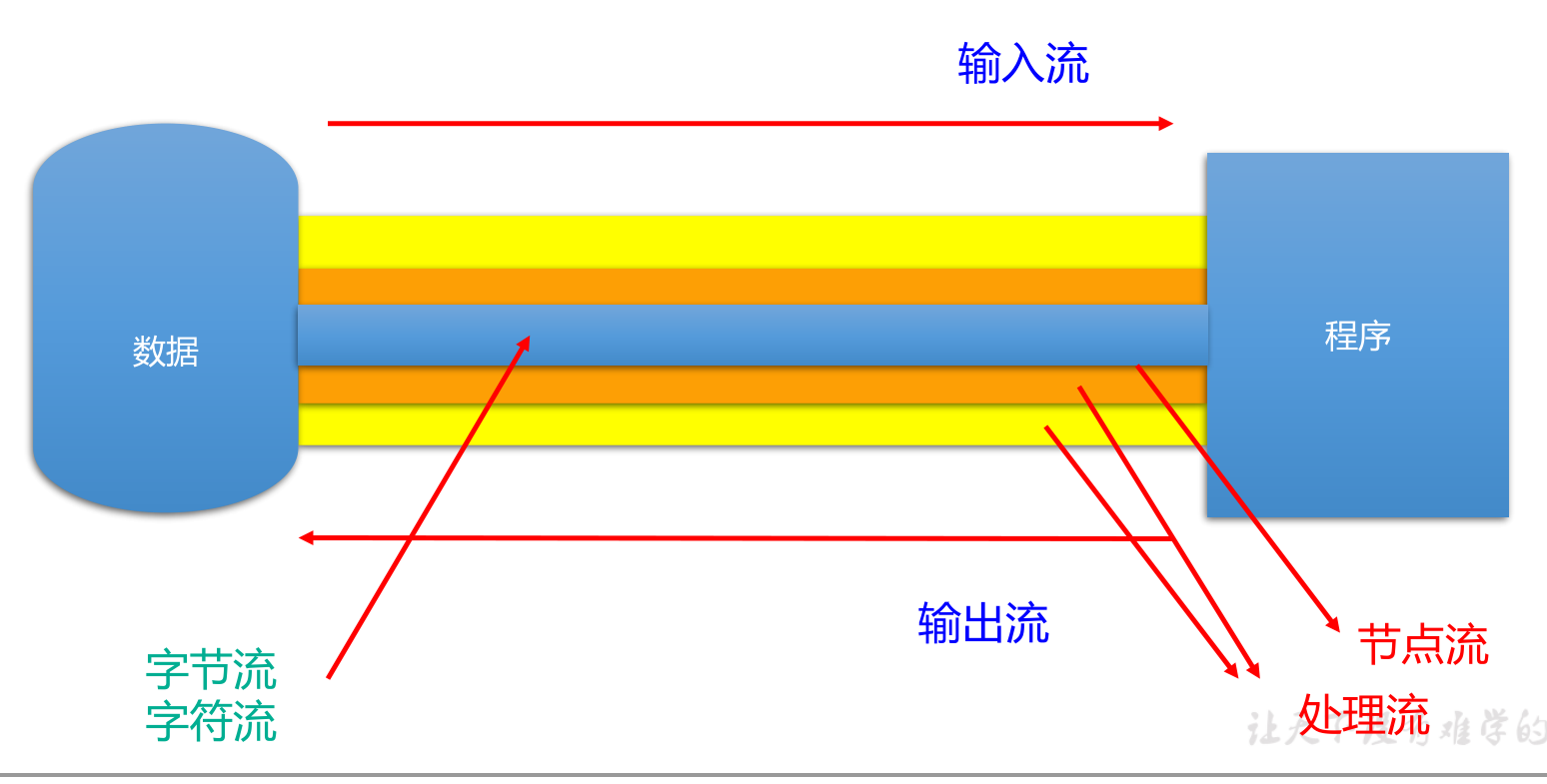
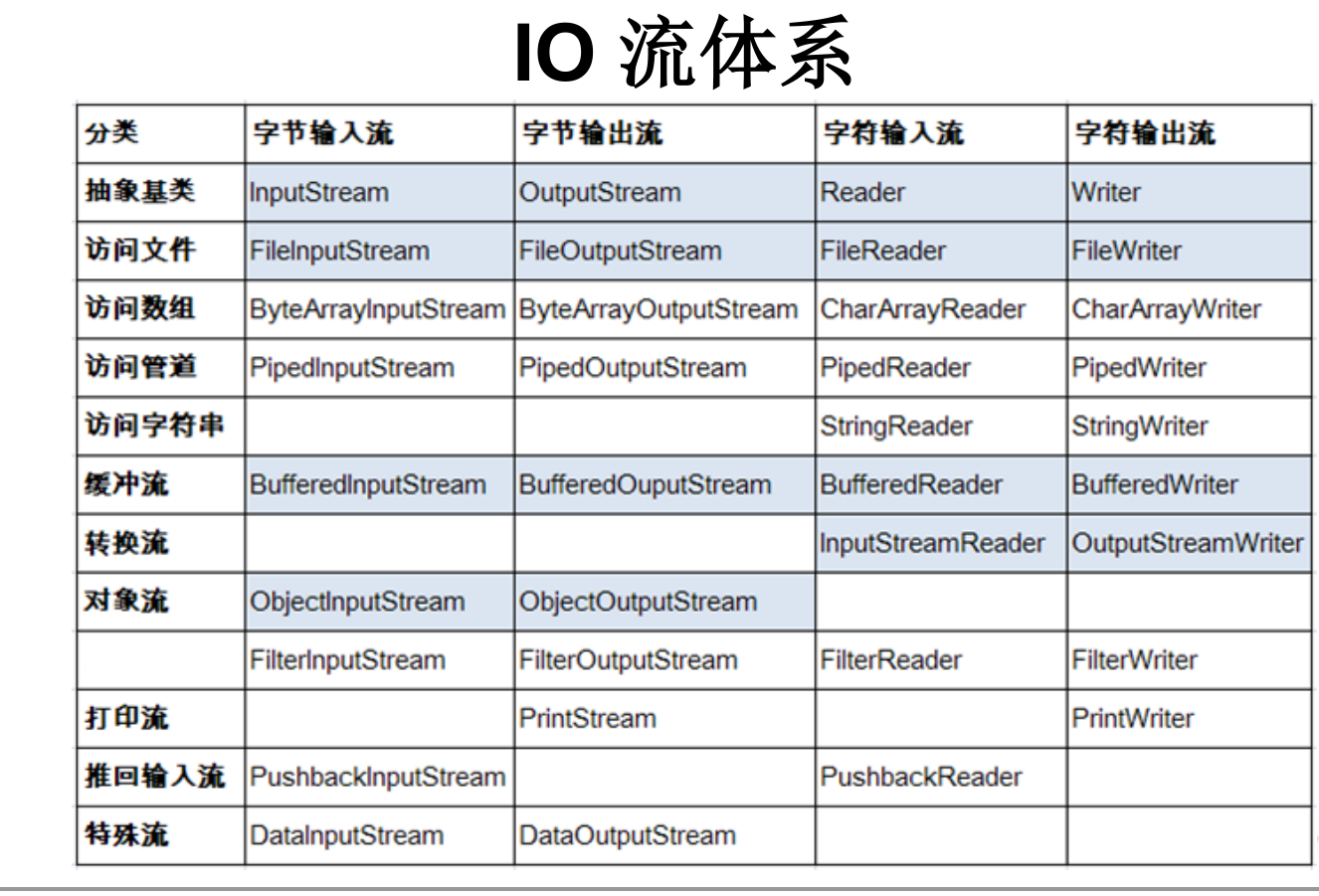
InputStream & Reader
- InputStream 和 Reader 是所有输入流的基类
- InputStream (典型实现 :FileInputStream)
- int read()
- int read(byte[] b)
- int read(byte[] b, int off, int len)
- Reader (典型实现 :FileReader)
- int read()
- int read(byte[] b)
- int read(byte[] b, int off, int len)
- 打开的 IO 资源需要显示的关闭 IO 资源
- FileInputStream 读取非文本数据的原始字节流 。
- FileReader 读取字符流 文本数据 。
InputStream
- int read()
从输入流中读取数据的下一个字节。返回 0 到 255 范围内的 int 字节值。如果因为已经到达流末尾而没有可用的字节,则返回值 -1
- int read(byte[] b)
从此输入流中将最多 b.length 个字节的数据读入一个 byte 数组中。如果因为已经到达流末尾而没有可用的字节,则返回值 -1。否则以整数形式返回实际读取的字节数
- int read(byte[] b, int off, int len)
将输入流中最多 len 个数据字节读入 byte 数组。尝试读取 len 个字节,但读取的字节也可能小于该值。以整数形式返回实际读取的字节数。如果因为流位于文件末尾而没有可用的字节,则返回值 -1
- public void close() throws IOException
关闭此输入流,释放资源
Reader
- int read()
读取单个字符。作为整数 读取的字符,范围在 0-65535 之间 (0x00=0xffff) (两个字节的 Unicode码),如果已达到流的末尾 ,返回-1.
- int read(byte[] b)
将字符读入数组。如果已到达流的末尾,则返回 -1。否则返回本次读取的字符数
- int read(byte[] b, int off, int len)
将字符读入数组的某一部分。存到数组cbuf中,从off处开始存储,最多读len个字符。如果已到达流的末尾,则返回 -1。否则返回本次读取的字符数
- public void close() throws IOException
关闭此输入流,释放资源
OutputStream & Writer
OutputStream 和 Writer 是所有输出流的基类
- void write(int b);
- void write(byte[] b);
- void write(byte[] b, int off, int len);
- void flush();
- void close(); 先刷新 ,在关闭输出流 。
字符流直接以字符作为操作单位 ,Writer 可以用字符串来代替字符数组 。使用 String 对象作为参数 。
- void writer(String str);
- void writer(String str, int off, int len);
FileOutputStream 用于写出非文本数据的原始字节流 。
FileWriter 用于写出字符流 。
OutputStream
- void write(int b)
将指定的字节写入此输出流。write 的常规协定是:向输出流写入一个字节。要写入的字节是参数 b 的八个低位。b 的 24 个高位将被忽略。 即写入0~255范围的。 - void write(byte[] b)
将 b.length 个字节从指定的 byte 数组写入此输出流。write(b) 的常规协定是:应该与调用 write(b, 0, b.length) 的效果完全相同。 - void write(byte[] b,int off,int len)
将指定 byte 数组中从偏移量 off 开始的 len 个字节写入此输出流。 - public void flush()throws IOException
刷新此输出流并强制写出所有缓冲的输出字节,调用此方法指示应将这些字节立即写入它们预期的目标。 - public void close() throws IOException
关闭输出流并释放系统资源。
Writer
-
void write(int c)
写入单个字符。要写入的字符包含在给定整数值的 16 个低位中,16 高位被忽略。 即写入0 到 65535 之间的Unicode码。 -
void write(char[] cbuf)
写入字符数组。 -
void write(char[] cbuf,int off,int len)
写入字符数组的某一部分。从off开始,写入len个字符 -
void write(String str)
写入字符串。 -
void write(String str,int off,int len)
写入字符串的某一部分。 -
void flush()
刷新该流的缓冲,则立即将它们写入预期目标。 -
public void close() throws IOException
关闭输出流并释放系统资源。
节点流和处理流
节点流 :
直接从数据源或目的地读写数据

- 节点流(文件流)
读取文件
1、建立一个流对象 ,将已存在的一个文件加载进流 。
FileReader file = new FileReader(new File("D:\\Test.txt"));
2、创建一个临时存放数据的数组 。
Char[] b = new char[1024];
3、调用流对象的读取方法将流中的数据读入到数组中 。
file.read(b);
4、关闭资源 。
file.close();
示例 :
@Test
public void test07() throws IOException {
FileReader fileReader = null;
try {
fileReader = new FileReader(new File("G:\\aaa.txt"));
char[] buff = new char[1024];
int len;
while ((len = fileReader.read(buff)) != -1) {
System.out.println(new String(buff, 0, len)); // AAAAABBBBCCC
}
} catch (IOException e) {
e.printStackTrace();
} finally {
fileReader.close();
}
}
写入文件
1、创建流对象 ,建立数据存放文件
FileWriter fw = new FileWriter("G:\\aaa.txt");
2、调用流对象的写入方法 ,将数据写入流 。
fw.write("yuanwu"); // 会清空文件原有的数据
3、关闭流资源 。并将流中的数据清空到文件中 。
fw.close();
示例 :
@Test
public void test07() throws IOException {
FileWriter fileWriter = null;
try {
fileWriter = new FileWriter(new File("G:\\aaa.txt"));
fileWriter.write("yuanwu");
} catch (IOException e) {
e.printStackTrace();
} finally {
fileWriter.close();
}
}
写入注意事项 :如果不希望原有的数据被覆盖 ,在构造器参数增加 true,在文件内容末尾追加内容 。
fileWriter = new FileWriter(new File("G:\\aaa.txt"),true);
在读取文件时 ,必须保证该文件已存在,否则报异常 。
- 温馨提示
字节流操作字节 :.mp3、.avi、.rmvb、.mp4、.jpg、.ppt、.doc
字符流操作字符 :只能操作普通文本文件 .txt、.java、.c、等。word 、excel、 ppt 不是文本文件 。
FileInputStream 读数据
@Test
public void test11() {
FileInputStream fis = null;
try {
// 造文件
File file = new File("G:\\aaa.txt");
// 造流
fis = new FileInputStream(file);
// 读数据
byte[] buffer = new byte[100];
int len ; // 记录每次读取的字节的个数
while ((len = fis.read(buffer)) != -1) {
String s = new String(buffer, 0, len);
System.out.println(s);
}
} catch (FileNotFoundException e) {
e.printStackTrace();
} catch (IOException e) {
e.printStackTrace();
} finally {
// 关闭资源
try {
fis.close();
} catch (IOException e) {
e.printStackTrace();
}
}
}
FileOutputStream 写数据
@Test
public void test12() {
FileOutputStream fos = null;
// 造文件
File file = new File("G:\\aaa.txt");
try {
// 造流(字节输出流) 参数 true ,不会覆盖原有的内容 。
fos = new FileOutputStream(file,true);
fos.write(98); // 写入字节数据 小写b
} catch (FileNotFoundException e) {
e.printStackTrace();
} catch (IOException e) {
e.printStackTrace();
} finally {
// 关闭资源
try {
fos.close();
} catch (IOException e) {
e.printStackTrace();
}
}
}
FileInputStream & FileOutputStream :操作图片案例(复制图片)
示例 :
@Test
public void test10() {
FileInputStream fis = null;
FileOutputStream fos = null;
try {
// 1、创建 File 类的对象,指明读入和写出的文件
File file1 = new File("xxx.png");
File file2 = new File("aaa.png");
// 2、创建输入流和输出流的对象 (操作字节)
fis = new FileInputStream(file1);
fos = new FileOutputStream(file2);
// 3、数据的读入和写出操作
byte[] buf = new byte[1024];
int len; // 记录每次读入到 buf数组的字节的个数
while ((len = fis.read(buf)) != -1) {
// 每次写出 len 个字节
fos.write(buf, 0, len);
}
} catch (FileNotFoundException e) {
e.printStackTrace();
} catch (IOException e) {
e.printStackTrace();
} finally {
// 4、关闭流资源
try {
fos.close();
} catch (IOException e) {
e.printStackTrace();
}
try {
fis.close();
} catch (IOException e) {
e.printStackTrace();
}
}
}
处理流 :
列举三种常用处理流 。
目的 :提高文件的读写效率 。
不直接连接到数据源或目的地,而是 “连接” 在已存在的流 (节点流或处理流) 之上 。通过对数据的处理为程序提供更为强大的读写功能 。

处理流之一 :缓冲流
-
使用缓冲流时 ,会创建一个内部缓冲区数组,缺省使用 8192个字节(8kb) 的缓冲区 。
-
使用缓冲流要 “套接” 在相应的节点流上 。根据数据操作类型可分为如下几种 :
- BufferedInputStream 和 BufferedOutputStream
- BufferedReader 和 BufferedWriter
BufferedInputStream
字节缓冲输入流
-
当使用 BufferedInputStream 读取字节文件时,BufferedInputStream 会一次性从文件中读取 8192 个字节(8Kb),放在缓冲区中,直到缓冲区满了才重新从文件中读取下一个 8192 个字节数组 。
-
向流中写入字节时,不会直接写到文件,先写到缓冲区中直到缓冲区满,BufferedInputStream 才会把缓冲区中的数据一次性写到文件里,使用 flush() 方法可以强制将缓冲区的内容全部写入输出流 。
-
flush() 方法的使用 :手动将 buffer 中内容写入文件里。
BufferedOutputStream
字节缓冲输出流
BufferedInputStream 和 BufferedOutputStream 案例 :实现非文本文件的复制
@Test
public void test13() {
BufferedInputStream bis = null;
BufferedOutputStream bos = null;
try {
// 造文件
File srcFile = new File("G:\\aaa.txt");
File destFile = new File("G:\\aaa1.txt");
// 造流
// 字节流
FileInputStream fis = new FileInputStream(srcFile);
FileOutputStream fos = new FileOutputStream(destFile);
// 缓冲流
bis = new BufferedInputStream(fis);
bos = new BufferedOutputStream(fos);
// 复制的细节 :读取、写入
byte[] buffer = new byte[1024];
int len;
while ((len = bis.read(buffer)) != -1) {
bos.write(buffer, 0, len);
}
} catch (FileNotFoundException e) {
e.printStackTrace();
} catch (IOException e) {
e.printStackTrace();
} finally {
// 关闭流资源
try {
bos.close();
} catch (IOException e) {
e.printStackTrace();
}
try {
bis.close();
} catch (IOException e) {
e.printStackTrace();
}
}
}
BufferedReader
BufferedReader是为了提供读的效率而设计的一个包装类,可以包装字符流。可以从字符输入流读取文本,缓冲各个字符,从而实现高效读取
BufferedWriter
字符缓冲输出流,把数据写入到文件
- 使用缓冲区将字节缓冲到内存中,比从硬盘读取的效率要高 。
示例 :
将 aaa.txt 文件的内容写入到 bbb.txt .但是写入的内容 会将 bbb.txt原有的内容覆盖掉 。
@Test
public void test08() throws IOException {
BufferedReader br = null;
BufferedWriter bw = null;
try {
// 创建缓冲流对象,它是处理流,对节点流的包装
br = new BufferedReader(new FileReader("G:\\aaa.txt"));
bw = new BufferedWriter(new FileWriter("G:\\bbb.txt"));
/* 方式一 :
char[] buff = new char[1024];
int len;
while ((len = br.read(buff)) != -1) {
bw.write(buff,0,len);
}
*/
String str = "";
// 一次读取字符文本文件的一行字符
while ((str = br.readLine()) != null) {
bw.write(str); // 一次写入一行字符串
bw.newLine(); // 写入分隔符
}
// 刷新缓冲区,手动将 bw 中内容写入文件里
bw.flush();
} catch (IOException e) {
e.printStackTrace();
} finally {
bw.close(); // 关闭流
try {
br.close();
} catch (IOException e) {
e.printStackTrace();
}
}
}
缓冲流案例 :字符在文件中出现的个数
@Test
public void test14() {
FileReader fr = null;
BufferedWriter bw = null;
Map<Character, Integer> map = new HashMap<>();
try {
fr = new FileReader("G:\\aaa.txt");
int len = 0;
while ((len = fr.read()) != -1) {
char c = (char) len;
// 判断 字符是否在map中第一次出现 。
if (map.get(c) == null) {
map.put(c, 1);
} else {
map.put(c, map.get(c) + 1);
}
}
// 把map中数据存在ccc.txt
// 创建流
bw = new BufferedWriter(new FileWriter("G:\\ccc.txt"));
// 遍历 map,再写入数据
Set<Map.Entry<Character, Integer>> entrySet = map.entrySet();
for (Map.Entry<Character, Integer> entry : entrySet) {
switch (entry.getKey()) {
// 特殊符号
case ' ':
bw.write( "空格=" + entry.getValue());
break;
case '\t':
bw.write("tab=" + entry.getValue());
break;
case '\n':
bw.write("换行=" + entry.getValue());
break;
case '\r':
bw.write("回车=" + entry.getValue());
break;
// 字符
default:
bw.write(entry.getKey() + "=" + entry.getValue());
break;
}
bw.newLine();
}
} catch (Exception e) {
e.printStackTrace();
} finally {
try {
bw.close();
} catch (IOException e) {
e.printStackTrace();
}
try {
fr.close();
} catch (IOException e) {
e.printStackTrace();
}
}
}
节点流之二 :转换流
属于字符流 。
解码 :字节、字节数组——>字符数组、字符串 InputStreamReader
编码 :字符数组 、字符串——> 字节、字节数组 OutputStreamWriter
转换流提供 字节流和字符流之间的相互转换 。字节流中的数据都是字符时,转成字符流操作更高效 。
InputStreamReader:将InputStream转换为Reader
OutputStreamWriter:将Writer转换为OutputStream
使用转换流来处理文件乱码问题,实现编码和解码功能 。
InputStreamReader
- 实现将字节的输入流转换为字符的输入流 (按指定字符集)
- 需要和 InputStream “套接”
- 构造器
public InputStreamReader(InputStream in)
public InputStreamReader(InputStream in, String charsetName)
例子 :Reader isr = new InputStreamReader(System.in, "UTF-8");
OutputStreamWriter
- 实现将字符的输出流转换为字节的输出流 (按指定字符集)
- 需要和 OutputStream "套接"
- 构造器
public OutputStreamWriter(OutputStream out)
public OutputSreamWriter(OutputStream out,String charsetName)
例子 :Writer wri = new OutPutStreamWriter(System.out, "GBK");
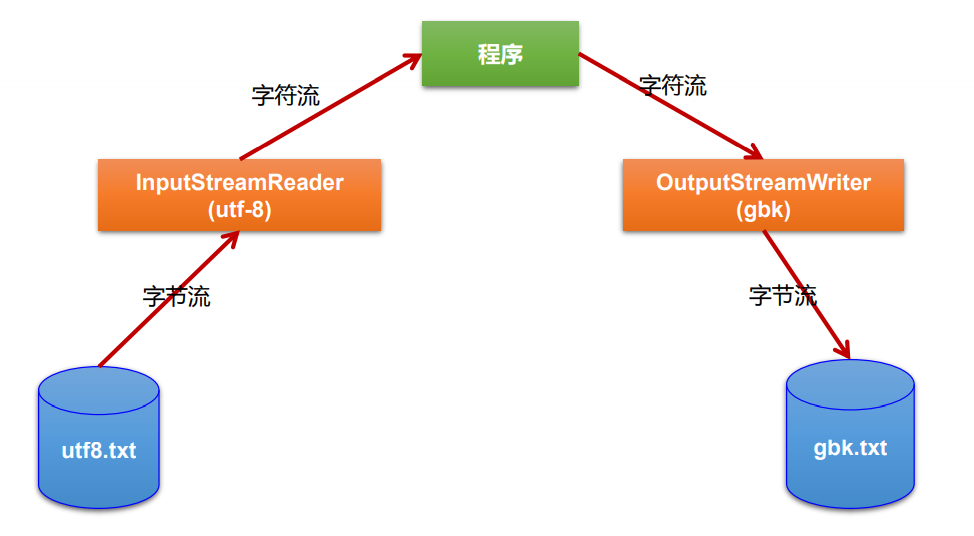
示例 :
FileInputStream:是InputStream具体实现类 ,文件字节输入流 ,对文件数据以字节的形式进行读取操作 。
FileOutputStream:是OutputStream具体实现类,文件字节输出流 ,用于将数据写入到文件中 。第二个参数传 true ,则写入的数据是从末尾追加内容 。
InputStreamReader:需要和 InputStream “套接”,(传入InputStream 实现类 FileInputStream ,再传入字符编码 )。
OutputStreamWriter:需要和 OutputStream “套接”,(传入OutputStream 实现类 OutputStreamWriter ,再传入字符编码) 。BufferedReader , BufferedWriter :缓冲流 。
示例一 :将 GBK 格式数据 以 GBK/UTF-8 写出
@Test
public void test09() throws Exception {
// 造文件、造流
FileInputStream fileInputStream = new FileInputStream("G:\\aaa.txt");
FileOutputStream fileOutputStream = new FileOutputStream("G:\\bbb.txt");
// 解码过程 读入
InputStreamReader gbk = new InputStreamReader(fileInputStream, "GBK");
// 编码过程 写出
OutputStreamWriter gbk1 = new OutputStreamWriter(fileOutputStream, "GBK");
BufferedReader bufferedReader = new BufferedReader(gbk);
BufferedWriter bufferedWriter = new BufferedWriter(gbk1);
// 读写过程
String str = null;
while ((str = bufferedReader.readLine()) != null) {
bufferedWriter.write(str);
bufferedWriter.newLine();
bufferedWriter.flush();
}
// 关闭资源
bufferedWriter.close();
bufferedReader.close();
}
示例二 :将数据在控制台中打印
解码操作 :字节、字节数组——>字符数组、字符串
InputStreamReader
@Test
public void test15() {
try {
FileInputStream fis = new FileInputStream("G:\\aaa.txt");
InputStreamReader isr = new InputStreamReader(fis, "UTF-8");
char[] buff = new char[20];
int len ;
while ((len = isr.read(buff)) != -1) {
String s = new String(buff, 0, len);
System.out.println(s);
}
isr.close();
} catch (Exception e) {
e.printStackTrace();
} finally {
}
}
处理流之三 :对象流
简介 :
- ObjectInputStream和OjbectOutputSteam
- 用于存储和读取基本数据类型数据或对象的处理流。它的强大之处就是可以把Java中的对象写入到数据源中,也能把对象从数据源中还原回来。
- 序列化:用
ObjectOutputStream类保存基本类型数据或对象的机制 - 反序列化:用
ObjectInputStream类读取基本类型数据或对象的机制 - ObjectOutputStream和ObjectInputStream不能序列化static和transient修 饰的成员变量
- 对象序列化机制允许把内存中的Java对象转换成平台无关的二进制流,从 而允许把这种二进制流持久地保存在磁盘上,或通过网络将这种二进制流传 输到另一个网络节点。//当其它程序获取了这种二进制流,就可以恢复成原 来的Java对象
自定义类序列化 需实现 Serializable 接口,这个接口是个空方法接口 ,用于标识 ,并且 还要加上 UID。模板如下 :
private static final long serialVersionUID = 6805652262626734654L;
案例 :序列化
@Test
public void test01() {
ObjectOutputStream oos = null;
try {
oos = new ObjectOutputStream(new FileOutputStream("G:\\aaa1.dat"));
// oos.writeObject(new Person("张三,18,"男","董事长"));
oos.writeUTF(new String("我爱中国"));
oos.flush();
} catch (IOException e) {
e.printStackTrace();
} finally {
try {
oos.close();
} catch (IOException e) {
}
}
}
案例 :反序列化
@Test
public void test02() {
ObjectInputStream ois = null;
try {
ois = new ObjectInputStream(new FileInputStream("G:\\aaa1.dat"));
// Object obj = ois.readObject();
// String str = (String)obj;
String readUTF = ois.readUTF();
System.out.println(readUTF); // 我爱中国
} catch (Exception e) {
e.printStackTrace();
} finally {
try {
ois.close();
} catch (IOException e) {
e.printStackTrace();
}
}
}
其实往后面 ,用到的都是现成的 序列化和反序列化 ,JSON 格式 "{"name":"Tom"}" ......
常用流的基本应用小结
- 流是用来处理数据的
- 处理数据时,一定要先明确 数据源,与数据目的地
- 数据源可以是文件中,可以是键盘
- 数据目的地可以是文件、显示器 或其他设备 。
- 流只是在帮助数据进行传输,并对传输的数据进行处理。如:过滤数据、转换数据等等。
NIO 概述
NIO 是从 java 1.4 版本引入的 IO API 。NIO与原来的IO有同样的作用和目的,但使用方式不同。NIO支持面向缓冲区 (IO时面向流) 、基于通道的IO操作,NIO 更加高效的方式进行文件的读写操作 。
针对标准输入输出NIO ,网络编程NIO 。
核心API
Path、Paths、Files ,核心API 。
Files 包含大量的静态工具方法来操作文件 ;
Paths 包含了两个返回 Path 的静态工厂方法 。
Java 7 之前 语法 :
import java.io.File;
File file = new File("xxx.txt");
Java 7 之后的语法 :
import java.nio.file.Path;
import java.nio.file.Paths;
Path path = Paths.get("xxx.txt");
- Paths 类提供的静态 get() 方法用来获取 Path 对象 。
| 方法名称 | 作用 |
|---|---|
public static Path get(String first, String... more) |
用于将多个字符串 串连成路径 。 |
public static Path get(URI uri) |
返回指定 uri 对应的 Path 路径 |
- Path 接口 常用方法
| 方法名称 | 作用 |
|---|---|
String toString |
返回调用 Path 对象的字符串表示形式 |
boolean startsWith(String path) |
判断是否以 path 路径开始 |
boolean endsWith(String path) |
判断是否以 path 路径结束 |
boolean isAbsolute() |
判断是否是绝对路径 |
Path getParent() |
返回Path对象包含整个路径,不包含 Path 对象指定的文件路径 |
Path getRoot() |
返回调用 Path 对象的根路径 |
Path getFileName() |
返回与调用 Path 对象关联的文件名 |
int getNameCount() |
返回Path 根目录后面元素的数量 |
Path getName(int idx) |
返回指定索引位置 idx 的路径名称 |
Path toAbsolutePath() |
作为绝对路径返回调用 Path 对象 |
Path resolve(Path p) |
合并两个路径,返回合并后的路径对应的Path对象 |
File toFile() |
将Path转化为File类的对象 |
- Files 类的常用方法
java.nio.file.Files 用于操作文件或目录的工具类 。
| 方法名称 | 作用 |
|---|---|
static Path copy(Path source, Path target, CopyOption... options) |
文件复制 |
static Path createDirectory(Path dir, FileAttribute<?>... attrs) |
创建一个目录 |
static Path createFile(Path path, FileAttribute<?>... attrs) |
创建一个文件 |
static void delete(Path path) |
删除一个文件/目录,不存在则报错 |
static boolean deleteIfExists(Path path) |
Path 对应的文件/目录若存在,执行删除 |
static Path move(Path source, Path target, CopyOption... options) |
将 source 移动到 target位置 |
static long size(Path path) |
返回 path 指定文件的大小 |
- Files 类常用方法 :用于判断
| 方法名称 | 作用 |
|---|---|
boolean exists(Path path, LinkOption … opts) |
判断文件是否存在 |
boolean isDirectory(Path path, LinkOption … opts) |
判断是否为目录 |
boolean isRegularFile(Path path, LinkOption … opts) |
判断是否是文件 |
boolean isHidden(Path path) |
判断是否是隐藏文件 |
boolean isReadable(Path path) |
判断文件是否可读 |
boolean isWritable(Path path) |
判断文件是否可写 |
boolean notExists(Path path, LinkOption … opts) |
判断文件是否不存在 |
- Files 类的常用方法 :用于操作内容
| 方法名称 | 作用 |
|---|---|
| static SeekableByteChannel newByteChannel(Path path, OpenOption... options) | 获取与指定文件的连接 options 为指定打开方式 |
| static DirectoryStream |
打开 dir 指定的目录 |
| static InputStream newInputStream(Path path, OpenOption... options) | 获取 InputStream 对象 |
| static OutputStream newOutputStream(Path path, OpenOption... options) | 获取 OutputStream 对象 |




 浙公网安备 33010602011771号
浙公网安备 33010602011771号